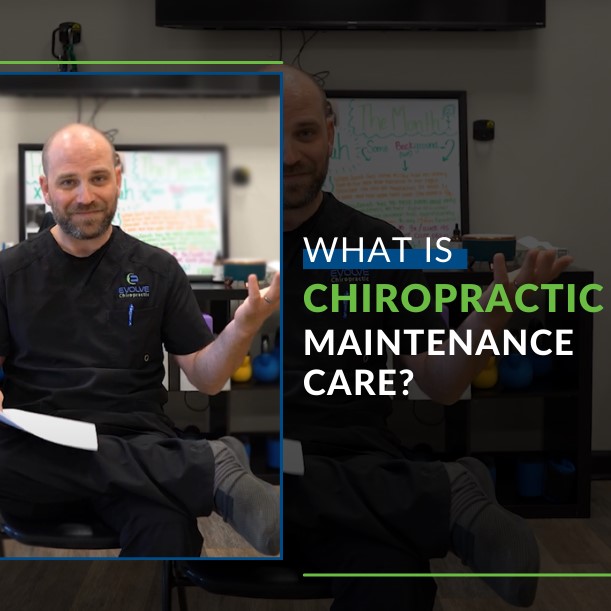What do you do when experiencing back pain, chronic neck pain, or any other recurrent and persistent pain in your body?
If you’re like many chiropractic patients, you probably schedule a few chiropractic visits, feel better after a couple of sessions, and then go back to daily life – until the pain returns. And just like that, you’re stuck in a reactive cycle of symptoms, relief, and recurrence.
So, then the big question is, “What if you don’t stop going to your chiropractor after the initial improvement?”
That’s where chiropractic maintenance care comes in. Instead of treating pain after it appears, maintenance therapy emphasizes consistency – continuing care even after symptoms improve to promote healing, prevent relapse, and support overall health. Backed by research like the Nordic maintenance care program, this proactive model focuses on long-term results.
In this article, we’ll define maintenance care, explore the science behind it, and help you decide if it’s the right step in your journey to better spinal health.
What is Chiropractic Maintenance Care?
Chiropractic maintenance care is a long-term, preventive approach that continues after a patient’s initial improvement. Rather than waiting for pain to return, this model relies on regular chiropractic adjustments to support optimal function of the spine and nervous system. It differs from symptom-guided care – which is reactive – by focusing on sustaining progress and reducing the risk of future episodes.
According to a 2018 randomized controlled trial, maintenance care is defined as “a strategy used for patients with recurrent or persistent low back pain who respond well to chiropractic care,” with the goal of maintaining reduced pain and preventing relapses through scheduled visits – even in the absence of symptoms. The study found that patients receiving maintenance care experienced fewer days with bothersome low back pain than those treated only when pain returned.
A 2020 review by Axén et al. in Chiropractic & Manual Therapies reinforced this definition, emphasizing that maintenance care is most effective for individuals with a history of recurring pain who respond positively to initial chiropractic treatment. The review stressed that care should be individualized and based on each patient’s clinical presentation and risk for recurrence.
The overall goal of chiropractic maintenance is to preserve spinal stability, improve quality of life, and promote long-term health. Treatment plans typically involve scheduled chiropractic visits every 1 to 3 months, depending on lifestyle, age, and health goals – making maintenance care a proactive solution rather than a response to pain.

The Difference Between Sporadic Chiropractic Care and Maintenance Care
While chiropractic care is widely known for addressing acute issues like back or neck pain, maintenance chiropractic care is more focused on wellness care and prevention.
Sporadic visits are usually symptom-driven – a chiropractic adjustment is scheduled when pain flares up. In contrast, regular chiropractic care means patients return for scheduled check-ins, regardless of symptoms, to keep their body functioning optimally.
This approach is best suited for individuals looking to improve posture, reduce tension, support an active lifestyle, or manage a chronic condition. For example:
- A former athlete may come in monthly to prevent recurring joint issues.
- A desk-bound professional may schedule visits to counteract posture-related stress.
- An older adult may opt for quarterly visits to support mobility and independence.
The goal is to stay ahead of pain before it becomes a problem.
What Does a Maintenance Care Visit Look Like?
A typical maintenance visit starts with an evaluation. The chiropractor checks the spinal alignment, posture, mobility, and looks for subtle dysfunctions.
From there, they may apply chiropractic spinal manipulation, soft tissue techniques, or use instruments to make corrections. These interventions are part of physiological therapeutics, designed to improve range of motion, minimize inflammation, and restore balance in the nervous system.
Indicators your chiropractor may assess:
- Joint restrictions or stiffness
- Minor spinal misalignments
- Postural imbalances
- Muscle tension or weakness
Unlike an initial treatment plan, these visits are shorter, more targeted, and geared toward fine-tuning function. Chiropractors also offer post-care advice – like ergonomic tips, stretches, or mobility drills – to help each patient stay well between sessions.

Who Should Try Maintenance Care?
Chiropractors often recommend maintenance care for individuals with a history of recurring low back pain or chronic musculoskeletal conditions. But it’s also ideal for anyone looking to optimize how they move, feel, and function on a daily basis.
You’re a great candidate for chiropractic maintenance if:
- You’ve had previous flare-ups and want to avoid relapse
- You value prevention over reaction
- You want to support nervous system health and mobility
- You live an active or physically demanding lifestyle
Chiropractic care should always be personalized and your provider will evaluate your specific needs, goals, and preferences before recommending a care schedule.
Does the Maintenance Method Really Work?
The effectiveness of chiropractic maintenance was a subject of debate within the medical and scientific communities. Some professionals reported positive outcomes and benefits from regular chiropractic visits, but others were quite skeptical about their long-term effectiveness.
Even though the debate isn’t finished yet, a lot has changed since the systematic research program in 2018.
Nordic Maintenance Care Program and Research
In a study from 2018, researchers from Sweden showed the benefits of maintenance care for a group of people with low back pain. In this study, the researchers followed 328 patients who suffered from low back pain and went to 40 different Swedish chiropractic clinics.
They began their research by checking if the patients responded well after the first adjustments. If they showed improvement, the researchers divided them into two groups – one that will receive chiropractic maintenance over the entire year and the other that will receive symptom-guided care. The rule was that maintenance care patients could only see chiropractors once every one to three months. And the intention was to check them before substantial pain returned.
On the other hand, the other group of patients was told to call only when the back pain came back. When these patients called, the chiropractors were adjusting them until they got better. And after that, they were once again told to call only if they experienced the same pain again.
The total number of days that each group experienced uncomfortable back pain during the one-year trial period piqued the researchers’ interest.
How did things turn out?
The results of this study showed that the maintenance care group experienced 13 fewer days of pain over the course of one year on average compared to the symptom-guided group. That led to the amazing conclusion that the maintenance group needed less than two extra visits to their chiropractor over the course of the year to have 13 fewer days of pain.

What Can We Learn from the Study?
This result suggested that patients who’ve had low back pain and respond well to chiropractic care should see their chiropractor regularly, regardless of whether the symptoms have returned or not.
After these results, around 30% of Scandinavian chiropractic patients tried maintenance care treatments and believed in their effectiveness.
Just like all studies, this one also has some limitations. One limitation was that the rule for maintenance care patients was not to see chiropractors more frequently than once a month.
If this were different and patients were allowed to visit more often, maybe some patients in this group would have benefited even more.
We don’t know for sure how the results would be if the chiropractors were able to schedule their visits more frequently if they thought that was a good idea.
Before researchers come up with new studies and results, we can say that maintenance care can be considered an evidence-based method to perform secondary or tertiary prevention in patients with previous issues with low back pain who reported good results from the initial treatments and experienced pain relief. Still, it’s important to note that these results should not be interpreted as a recommendation for maintenance care for all patients who receive chiropractic treatment.
What this study really shows is that it’s important to keep your spine working well, even if you don’t have pain or symptoms. If your goal is to function at your optimal potential, consider chiropractic maintenance care because the research suggests your spine will love you for it.
Contact us if you want to get rid of persistent or episodic pain and ensure a pain free life.
Citations
- The Nordic maintenance care program: patient experience of maintenance care – a qualitative study: https://chiromt.biomedcentral.com/articles/10.1186/s12998-021-00388-z
- Chiropractic maintenance care – what’s new? A systematic review of the literature: https://chiromt.biomedcentral.com/articles/10.1186/s12998-019-0283-6
Video Transcription
Hey, it’s Doctor Allin, D.C. here at Evolve Chiropractic here in Woodstock. I was going through an article today. This is back from 2020 but it was called the Nordic maintenance care research article. Basically, what they were looking at was does maintenance care help patients for low back pain.
So basically what maintenance care means is after you’re done with the treatment plan. Do you continue treatment even though the patient is asymptomatic? What this paper showed is that for a select group of patients. So these were patients with long term chronic low back patterns. So they would be flaring up multiple times throughout the year.
What they found was that after the initial stage of treatment, if the patients underwent a maintenance care program, basically, they were able to reduce the frequency of flare ups when flare ups did come on, they were much less intense and it affected much less days off of work. So a lot of the patients asked me like, do I need to keep coming?
Obviously? No, you don’t have to. But again, like maintenance care is specific to the individual. This was done specifically for chronic low back pain. I’ve personally seen patients with chronic headaches, migraines, different situations like that, that I have actually benefited from maintenance care. So more research is needed in this realm as to what maintenance care specifically helps.
But for chronic low back patients, definitely a good thing. If you have any questions or concerns, if you know somebody who has chronic low back pain or you yourself are dealing with chronic low back pain, you don’t have to suffer through these things. There’s helpful treatments that don’t reach for that pill bottle.
Give us a call here at the office. We’ll be glad to help you out. Be safe. Have fun. Get at it. I’ll see you soon.
{Note: This content is for educational purposes only and should not be taken as medical advice. If you or any other person has a medical concern, you should consult with your healthcare provider or seek other professional medical treatment. Never disregard professional medical advice or delay in seeking it because of something that have read on this blog or in any linked materials.}





